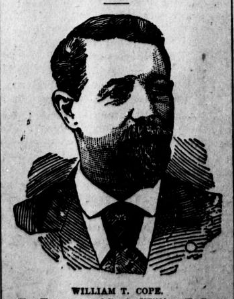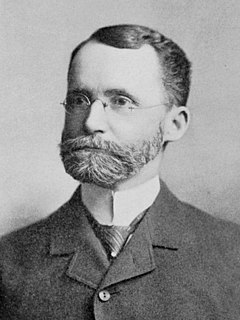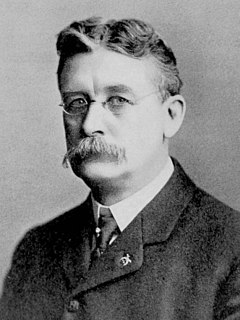| John C. Brown | |
|---|---|
 | |
| 20th Ohio State Treasurer | |
| In office January 11, 1886 –January 11, 1892 | |
| Governor | Joseph B. Foraker James E. Campbell |
| Preceded by | Peter Brady |
| Succeeded by | William T. Cope |
| Personal details | |
| Born | March 13, 1844 Jefferson County, Ohio |
| Died | November 22, 1900 (aged 56) Columbus, Ohio |
| Resting place | Green Lawn Cemetery |
| Political party | Republican |
| Spouse(s) | Malona Glover |
| Children | two |
| Military service | |
| Allegiance | United States |
| Service/branch | Union Army |
| Years of service | 1862–1864 |
| Unit | 52nd Ohio Infantry |
| Battles/wars | American Civil War |
John C. Brown (March 13, 1844 – November 22, 1900) [1] was a Republican politician in the state of Ohio and was Ohio State Treasurer from 1886–1892.

The Republican Party, also referred to as the GOP, is one of the two major political parties in the United States; the other is its historic rival, the Democratic Party.
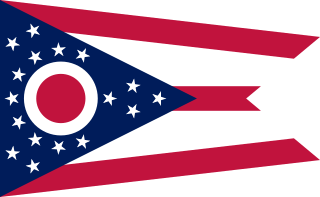
Ohio is a Midwestern state in the Great Lakes region of the United States. Of the fifty states, it is the 34th largest by area, the seventh most populous, and the tenth most densely populated. The state's capital and largest city is Columbus.

The treasurer of the U.S. State of Ohio is responsible for collecting and safeguarding taxes and fees, and managing state investments. The Treasury was located in the Ohio Statehouse from 1861 to 1974, when it was moved to the Rhodes State Office Tower. The original office in the statehouse has been restored to its nineteenth-century appearance, and is used for ceremonial events.
John C. Brown was born March 13, 1844 at Jefferson County, Ohio, and had not completed his public school education when the American Civil War broke out. [2] He enlisted in Company E, Fifty-second Ohio Volunteer Infantry in 1862. [3] His military career ended when he was injured at the Battle of Peachtree Creek and lost a leg July 19, 1864. [2]
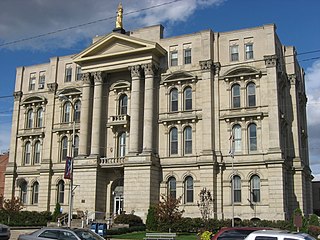
Jefferson County is a county located in the U.S. state of Ohio. As of the 2010 census, the population was 69,709. Its county seat is Steubenville. The county is named for Thomas Jefferson, who was Vice President at the time of its creation.

The American Civil War was a war fought in the United States from 1861 to 1865, between the North and the South. The Civil War is the most studied and written about episode in U.S. history. Primarily as a result of the long-standing controversy over the enslavement of black people, war broke out in April 1861 when secessionist forces attacked Fort Sumter in South Carolina shortly after Abraham Lincoln had been inaugurated as the President of the United States. The loyalists of the Union in the North proclaimed support for the Constitution. They faced secessionists of the Confederate States in the South, who advocated for states' rights to uphold slavery.
The 52nd Ohio Volunteer Infantry was an infantry regiment in the Union Army during the American Civil War.
After returning from war, he engaged in business in Steubenville, Ohio, where he was elected Jefferson County Treasurer in 1867 and 1869. He resumed private business, and was elected County Treasurer again in 1875 and 1877. In 1881 he was president of Steubenville City Council. [2]

Steubenville is a city in and the county seat of Jefferson County, Ohio, United States. Located along the Ohio River, it had a population of 18,659 at the 2010 census. The city's name is derived from Fort Steuben, a 1786 fort that sat within the city's current limits and was named for German-Prussian military officer Baron Friedrich Wilhelm von Steuben. Today, a replica of the fort is open to the public.
In 1883 Brown was nominated by the Republican Party for Ohio State Treasurer, but lost the general election. In 1885, 1887 and 1889 he won election as Ohio State Treasurer. In 1896 he was appointed cashier by State Treasurer Campbell. [2]
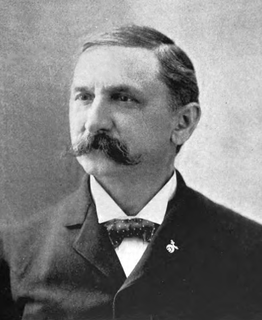
Samuel Bonsall Campbell (1846-1917) was a Republican politician in the state of Ohio and was Ohio State Treasurer from 1896-1900.
In 1885, Brown was married to Malona Glover of Jefferson County, and had one son and one daughter, who both survived him. [3] He was a member of the Grand Army of the Republic, and the First Methodist Episcopal Church. [3] He died November 22, 1900, and is interred at Green Lawn Cemetery, Columbus, Ohio [4]





